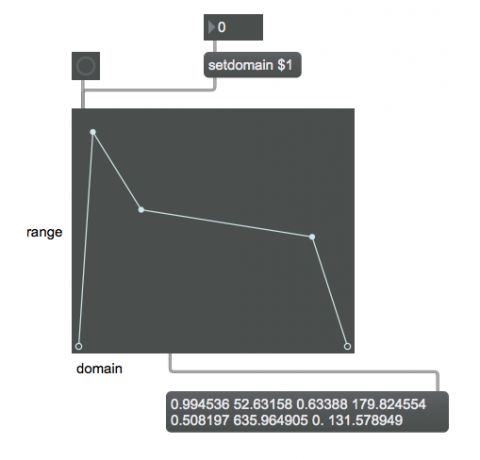The function object

The function object assists you to make shapes composed of line segments. When you send a bang to the function, it sends out of its second outlet a list of destination value and ramp time pairs suitable for use as input to a line~ object. In that way, the shape shown in the function object serves as a function over time, the shape of which will be enacted by the signal coming out of the line~ object.
A two-dimensional graph like the one shown here shows the relationship between two variables, x and y, and is said to be a graph of "y as a function of x" or "y over x". That means that it shows how the y variable changes with each corresponding x value. In most musical situations, the x-axis designates time (with x=0 designating a starting point in time) while y designates a value that changes over time according to a certain shape or curve. Since the x value (time) increases at a constant rate, the shape of the function shows us how y will change over time.
In math terminology, the minimum and maximum of the numbers on the x-axis are said to determine the "domain" of the function, and the minimum and maximum of the numbers on the y-axis determine the "range" of the function. By default, the domain of the function object is 0 to 1000 (since it's assumed that the domain will designate milliseconds), and the range is 0 to 1. But you can change the extent of the domain and the range with the messages setdomain and setrange. The minimum of the domain is always 0 in the function object, so you only need to provide the desired maximum with the setdomain message, as in setdomain 1000. For the range, you specify both the minimum and the maximum, as in setrange 0. 1.
Try changing the domain and the range, and then sending a bang to see how the resulting list changes. Notice that in this patch we use the pak object to combine the minimum and maximum values in a single setrange message. The pak object is used to combine several individual numbers together into a list, much like the pack object. The crucial difference between the two is that the pak object sends out a list any time it receives something in any inlet, whereas the pack object sends out a list only when it receives something in its leftmost inlet.